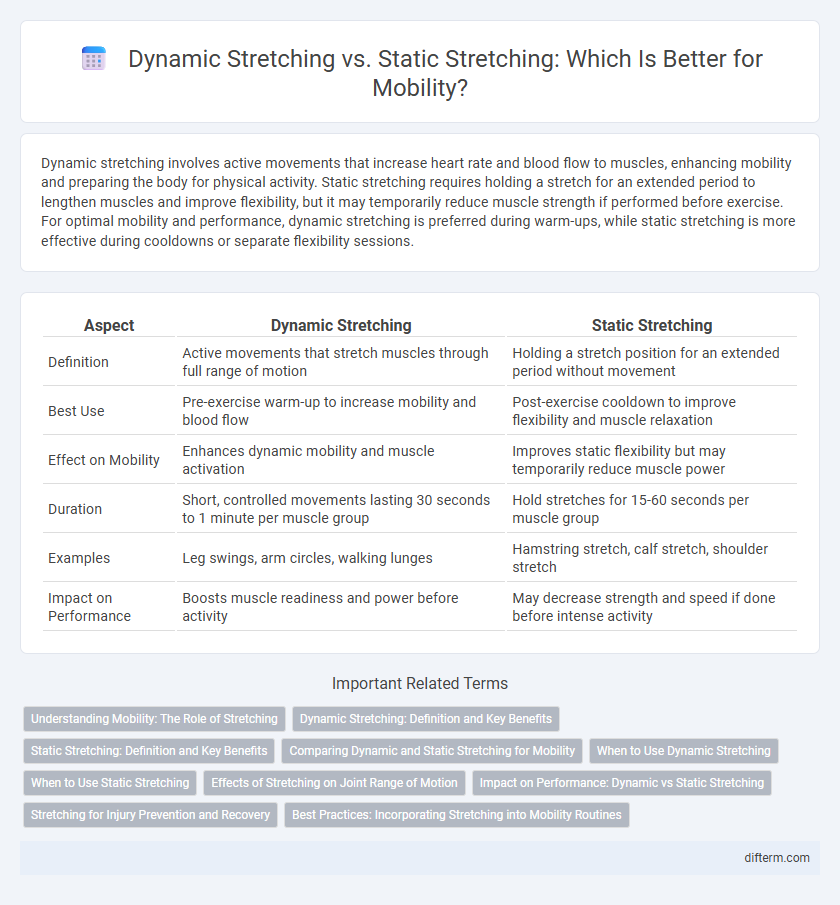Dynamic stretching involves active movements that increase heart rate and blood flow to muscles, enhancing mobility and preparing the body for physical activity. Static stretching requires holding a stretch for an extended period to lengthen muscles and improve flexibility, but it may temporarily reduce muscle strength if performed before exercise. For optimal mobility and performance, dynamic stretching is preferred during warm-ups, while static stretching is more effective during cooldowns or separate flexibility sessions.
Table of Comparison
| Aspect | Dynamic Stretching | Static Stretching |
|---|---|---|
| Definition | Active movements that stretch muscles through full range of motion | Holding a stretch position for an extended period without movement |
| Best Use | Pre-exercise warm-up to increase mobility and blood flow | Post-exercise cooldown to improve flexibility and muscle relaxation |
| Effect on Mobility | Enhances dynamic mobility and muscle activation | Improves static flexibility but may temporarily reduce muscle power |
| Duration | Short, controlled movements lasting 30 seconds to 1 minute per muscle group | Hold stretches for 15-60 seconds per muscle group |
| Examples | Leg swings, arm circles, walking lunges | Hamstring stretch, calf stretch, shoulder stretch |
| Impact on Performance | Boosts muscle readiness and power before activity | May decrease strength and speed if done before intense activity |
Understanding Mobility: The Role of Stretching
Dynamic stretching enhances mobility by actively preparing muscles and joints through movement, increasing blood flow and range of motion. Static stretching involves holding a stretch position for an extended period, improving flexibility but potentially reducing immediate muscle power if performed before activity. Integrating dynamic stretches before exercise and static stretches after supports optimal mobility and injury prevention.
Dynamic Stretching: Definition and Key Benefits
Dynamic stretching involves active movements that take joints and muscles through their full range of motion, enhancing blood flow and muscle temperature. It improves mobility by preparing the body for physical activity, increasing muscle elasticity and joint flexibility. Key benefits include enhanced athletic performance, reduced injury risk, and improved neuromuscular coordination.
Static Stretching: Definition and Key Benefits
Static stretching involves holding a muscle in a fixed position for 15 to 60 seconds, promoting increased flexibility and muscle relaxation. This technique enhances joint range of motion by elongating muscle fibers and connective tissues, which reduces injury risk during physical activities. Regular static stretching supports improved posture and muscle recovery, making it essential for maintaining overall mobility and preventing muscle stiffness.
Comparing Dynamic and Static Stretching for Mobility
Dynamic stretching improves mobility by actively engaging muscles through controlled movements, enhancing blood flow and muscle temperature, which prepares the body for physical activity. Static stretching involves holding a muscle in a fixed position for an extended period, which can increase flexibility by lengthening muscle fibers but may temporarily reduce muscle strength. Research shows dynamic stretching is more effective as a warm-up for mobility before exercise, while static stretching is better suited for post-activity recovery and long-term flexibility gains.
When to Use Dynamic Stretching
Dynamic stretching is most effective before physical activity because it increases blood flow, improves muscle elasticity, and enhances range of motion to prepare the body for movement. Athletes often use dynamic stretching as part of their warm-up routine to activate muscles and reduce the risk of injury during exercise. Incorporating dynamic stretches like leg swings, arm circles, and walking lunges helps optimize mobility and performance in sports and fitness activities.
When to Use Static Stretching
Static stretching is most effective after exercise when muscles are warm, helping to improve flexibility and reduce muscle stiffness. Post-workout static stretching enhances muscle recovery by gradually elongating muscle fibers and increasing blood flow. It is also beneficial during cool-down routines to prevent injury and maintain long-term mobility.
Effects of Stretching on Joint Range of Motion
Dynamic stretching enhances joint range of motion by actively engaging muscles through controlled movements, which increases blood flow and prepares the joints for activity. In contrast, static stretching involves holding a stretch for an extended period, leading to increased muscle length and joint flexibility but may temporarily reduce muscle strength. Research indicates that incorporating dynamic stretches before exercise optimizes performance, while static stretching is more effective post-exercise for improving long-term joint mobility.
Impact on Performance: Dynamic vs Static Stretching
Dynamic stretching enhances muscle activation and increases blood flow, leading to improved performance in activities requiring power, speed, and agility. Static stretching, when performed before exercise, can temporarily reduce muscle strength and explosive performance due to decreased muscle elasticity and neural activation. Athletes benefit from dynamic stretching routines as part of their warm-up to optimize mobility and maximize functional movement efficiency.
Stretching for Injury Prevention and Recovery
Dynamic stretching enhances blood flow and muscle elasticity, effectively preparing muscles for activity and reducing the risk of injury during movement. Static stretching, on the other hand, improves flexibility and aids muscle recovery by elongating muscle fibers post-exercise, which helps prevent stiffness and soreness. Incorporating dynamic stretching before workouts and static stretching after exercise optimizes injury prevention and accelerates recovery.
Best Practices: Incorporating Stretching into Mobility Routines
Dynamic stretching enhances mobility by increasing blood flow and muscle temperature, which prepares the body for activity and reduces injury risk. Static stretching is most effective post-exercise for improving flexibility and muscle relaxation, aiding recovery and reducing muscle stiffness. Incorporating dynamic stretches during warm-ups followed by static stretches during cool-downs optimizes mobility routines for performance and injury prevention.
dynamic stretching vs static stretching Infographic

 difterm.com
difterm.com